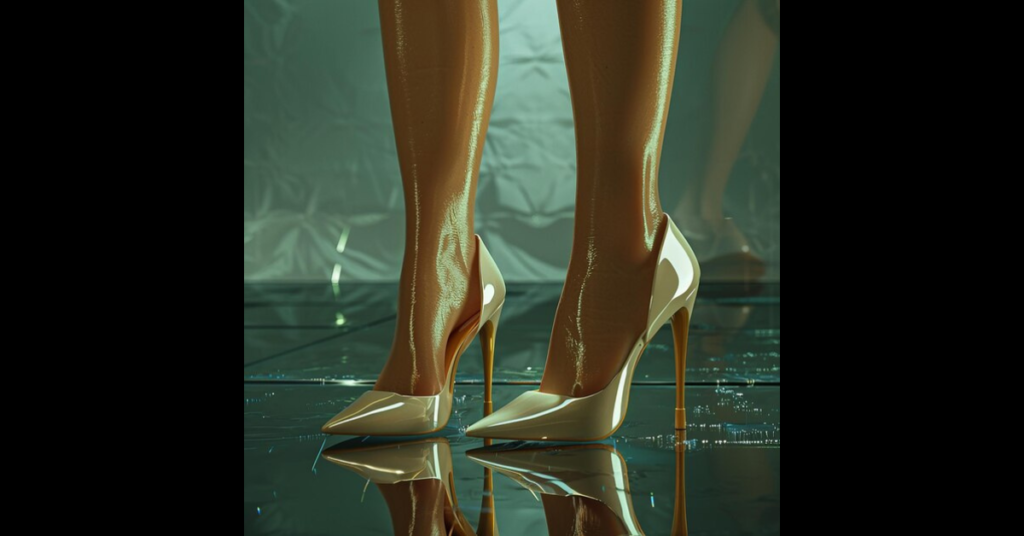Stilettos have long been a symbol of femininity, elegance, and power. From the runways of Paris to the streets of New York, stilettos have maintained their status as a staple in women’s fashion. But what exactly makes these high-heeled shoes so iconic? This article delves into the history, cultural significance, and style of stilettos, exploring their origins, evolution, and the reasons behind their enduring popularity.
1. The History of Stilettos
The history of stilettos is both fascinating and complex, tracing back centuries and involving various cultures and societal changes. The term “stiletto” is derived from the Italian word for a small dagger with a slender blade, which reflects the sharp, pointed nature of the heel.
1.1 Early Origins
High heels can be traced back to ancient Egypt, around 3500 B.C., where both men and women of the upper class wore shoes with elevated soles. These early versions were not stilettos as we know them today but were rather precursors that indicated status and wealth. In ancient Greece and Rome, platform shoes called “kothorni” were worn by actors to denote social status in theater.
In the 10th century, Persian horse riders wore high-heeled shoes to help them stay secure in stirrups while riding. This practical use of elevated footwear eventually influenced European fashion, particularly during the 16th and 17th centuries when heels became associated with nobility and royalty. Catherine de’ Medici, the Queen of France in the mid-16th century, is often credited with popularizing high heels in Europe when she wore them to appear taller and more commanding.
1.2 The Birth of the Modern Stiletto
The modern stiletto, with its thin, high heel, emerged in the early 20th century. It wasn’t until the 1950s, however, that stilettos as we know them truly came into fashion. Italian designer Salvatore Ferragamo and French designer Roger Vivier are often credited with creating the first modern stilettos. Vivier, working with the house of Christian Dior, designed the slim, pointed heel made from a steel rod, which gave the shoe its distinctive slender appearance and unprecedented height.
The post-war era was a time of great social change, and stilettos quickly became a symbol of the newfound freedom and sexual liberation of women. They were seen as a way to accentuate a woman’s legs and posture, enhancing the feminine silhouette and projecting confidence.
2. Cultural Significance of Stilettos
Stilettos have always been more than just a fashion item; they carry a rich tapestry of cultural meanings and associations.
2.1 Symbols of Power and Sexuality
Stilettos have long been associated with power and sexuality. They are often seen as a tool of seduction, enhancing a woman’s curves and elongating her legs, thus contributing to an alluring and commanding appearance. In various forms of media, from movies to music videos, stilettos are frequently worn by strong, assertive female characters, emphasizing their independence and confidence.
This symbolism is not without its complexities. Some feminist critiques have argued that stilettos are a form of patriarchal control, designed to physically restrict women’s movement and enforce gender norms related to beauty and femininity. Others, however, see stilettos as a form of empowerment, a way for women to assert their presence and command attention in a male-dominated world.
2.2 Fashion and Social Status
Historically, stilettos have been associated with social status and wealth. High-quality stilettos are often made from luxurious materials and crafted by skilled artisans, making them a symbol of affluence. In many cultures, the ability to wear high heels without the need for practicality suggests a life of leisure and privilege.
Today, stilettos are seen as a fashion statement that conveys a sense of style, sophistication, and attention to detail. High-end designers like Christian Louboutin, Manolo Blahnik, and Jimmy Choo have elevated the stiletto to an art form, creating iconic designs that are coveted by fashion enthusiasts worldwide.
3. The Anatomy of a Stiletto
To fully appreciate stilettos, it is essential to understand their anatomy and what sets them apart from other types of high-heeled shoes.
3.1 Heel Height and Shape
Stilettos are characterized by their tall, thin heels, which typically range from 2 to 6 inches in height, though some extreme versions can reach even higher. The defining feature of the stiletto heel is its narrowness, which gives the shoe a sleek and elegant appearance. The heel can be straight or slightly curved, depending on the design, but it always tapers to a small point at the bottom.
3.2 Material and Construction
The materials used in stiletto construction can vary widely, from leather and suede to satin and patent leather. The heel itself is often made from metal or plastic, reinforced with a steel rod to provide stability and support. The upper part of the shoe can be closed-toe, peep-toe, or strappy, and the sole is often made of leather or a synthetic material designed to provide grip.
High-quality stilettos are crafted using meticulous techniques to ensure both comfort and durability. The fit is crucial, as the wrong size or shape can cause discomfort or even injury. Many designers now incorporate cushioning and ergonomic design elements to make stilettos more comfortable to wear for extended periods.
4. Stilettos in Modern Fashion
The stiletto remains a central figure in modern fashion, constantly evolving to reflect current trends and societal changes.
4.1 Designer Innovations
Many contemporary designers have put their unique spin on the classic stiletto, experimenting with different materials, heel shapes, and embellishments. Brands like Christian Louboutin are known for their signature red soles, while Manolo Blahnik’s designs often feature intricate detailing and luxurious materials.
Designers have also begun to explore the concept of “hybrid” stilettos, combining traditional stiletto heels with elements of other shoe styles, such as boots or sneakers. This innovation has led to a new wave of creative and unexpected stiletto designs, appealing to a broader range of fashion tastes and preferences.
4.2 The Rise of the “Comfort Stiletto”
In response to the growing demand for more comfortable footwear, many designers have started to create stilettos with a focus on comfort without sacrificing style. Innovations like cushioned insoles, arch support, and wider toe boxes have made stilettos more accessible to women who want both style and comfort.
Brands like Cole Haan and Taryn Rose have pioneered the concept of the “comfort stiletto,” which combines the elegance of a high heel with the support and cushioning typically found in more practical footwear. These developments have helped to keep stilettos relevant in a fashion landscape that increasingly values both style and comfort.
5. The Psychology Behind Wearing Stilettos
Understanding the psychology behind why women choose to wear stilettos can provide deeper insight into their enduring appeal.
5.1 Confidence and Empowerment
Many women report feeling more confident and empowered when wearing stilettos. The added height can create a sense of authority and presence, making the wearer feel more assertive and self-assured. This psychological boost is one of the primary reasons stilettos remain a popular choice for professional and social settings alike.
5.2 Body Image and Aesthetics
Stilettos are often chosen for their ability to enhance a woman’s silhouette. The elongating effect of the heel can make the legs appear longer and leaner, while the arch created by the shoe can accentuate the natural curves of the body. This aesthetic appeal is a significant factor in why stilettos are often chosen for special occasions, such as weddings, parties, and red-carpet events.
6. The Challenges of Wearing Stilettos
Despite their many appeals, stilettos are not without their challenges. The design of the shoe can pose several health and safety risks, particularly when worn for extended periods.
6.1 Health Implications
Wearing stilettos’es can lead to several health issues, including back pain, knee problems, and foot injuries. The unnatural positioning of the foot can cause strain on the muscles and tendons, leading to conditions like plantar fasciitis, bunions, and metatarsalgia. Long-term use of high heels can also contribute to poor posture and balance, increasing the risk of falls and injuries.
To mitigate these risks, it is recommended that stilettos be worn in moderation and that women choose styles that provide adequate support and cushioning. Stretching exercises and foot care routines can also help to reduce the strain associated with wearing high heels.
6.2 Navigating Terrain and Social Settings
Walking in stilettos’es requires a certain level of skill and balance, particularly on uneven surfaces or in crowded settings. This challenge can make stilettos impractical for certain situations, such as outdoor events or long walks. Many women opt to carry a backup pair of flats or more comfortable shoes to switch into when necessary.
7. The Future of Stilettos
As fashion continues to evolve, so too does the role of stilettos’es. Designers and consumers alike are beginning to explore new possibilities for this iconic shoe, blending tradition with innovation to create fresh and exciting styles.
7.1 Sustainable Stiletto Design
Sustainability is becoming an increasingly important consideration in the fashion industry, and stilettos are no exception. Designers are beginning to experiment with eco-friendly materials and ethical production methods to create stilettos that are both stylish and sustainable. From vegan leather to recycled materials, the future of stilettos may lie in more environmentally conscious design practices.
7.2 Technological Advancements
Advancements in technology are also shaping the future of stilettos. 3D printing, for example, allows for the creation of custom-fitted shoes that can provide a more personalized and comfortable experience. Smart materials that adapt to the wearer’s foot shape and movement are also being explored, potentially revolutionizing the way stilettos are made and worn.
8. Cultural Representation in Media and Pop Culture
Stilettos have maintained a prominent place in media and pop culture, symbolizing everything from glamour to power. Movies, TV shows, and music videos often showcase stilettos to highlight a character’s personality or status.
8.1 Iconic Moments in Film and Television
From Marilyn Monroe’s classic scenes in “Some Like It Hot” to Carrie Bradshaw’s enviable shoe collection in “Sex and the City,” stilettos have played a key role in some of the most memorable moments in film and television. These representations have helped cement stilettos as a symbol of style, sophistication, and sometimes, rebellion.
8.2 Stilettos in Music and Fashion
Pop stars like Madonna, Lady Gaga, and Beyoncé have used stilettos as part of their stage personas, enhancing their performance and creating a visual impact that resonates with audiences. In fashion, stilettos are often used to complete a runway look, adding height and drama to the models’ silhouettes.
9. Stilettos as an Expression of Individuality
While stilettos’es have a long history of being associated with certain cultural meanings, they are also a form of self-expression. For many women, stilettos are a way to showcase their personal style, mood, and identity.
9.1 Customization and Personalization
In recent years, the trend of customizing and personalizing stilettos’es has gained popularity. From adding embellishments and unique designs to selecting custom colors and materials, women are finding new ways to make their stilettos uniquely their own. This trend reflects a broader movement towards individuality and self-expression in fashion.
9.2 The Role of Stilettos in Identity Politics
Stilettos’es have also become a symbol in discussions about identity politics, particularly in relation to gender and sexuality. They are often worn by individuals across the gender spectrum as a way to express femininity, challenge traditional gender norms, or simply for the aesthetic appeal. The cultural conversation around stilettos continues to evolve, reflecting broader societal changes and debates about gender and identity.
10. Conclusion: The Enduring Appeal of Stilettos
Stilettos’es are more than just a type of shoe; they are a cultural icon with a rich history and a powerful presence in fashion and society. Despite the challenges they present, stilettos remain a popular choice for many women, symbolizing confidence, elegance, and empowerment. As the fashion landscape continues to evolve, so too will the role of stilettos, ensuring that this timeless shoe continues to captivate and inspire for years to come.
From their historical origins to their modern iterations, stilettos’es have proven to be a versatile and enduring element of fashion. Whether viewed as a tool of empowerment or a statement of style, stilettos hold a unique place in the hearts and wardrobes of women around the world. Their ability to adapt to changing trends while maintaining their core appeal is a testament to their lasting significance and allure.







